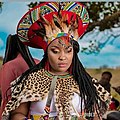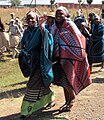| Part of a series on |
| Western dress codes and corresponding attires |
|---|
|
Legend:
|
A folk costume (also regional costume, national costume, traditional clothing, traditional garment or traditional regalia) expresses a national identity through clothing or costume, which is usually associated with a specific region or period of time in history. It can also indicate social, marital, or religious status. If the costume is used to represent the culture or identity of a specific ethnic group, it is usually known as ethnic costume (also ethnic dress, ethnic wear, ethnic clothing, traditional ethnic wear or traditional ethnic garment). Such costumes often come in two forms: one for everyday occasions, the other for traditional festivals and formal wear. The word "costume" in this context is sometimes considered pejorative due to the multiple senses of the word, and in such cases "clothing", "garments" or "regalia" can be substituted without offense.[1][2][3][4]
Following the rise of romantic nationalism[5] in parts of Europe, pre-industrial peasantry came to serve as models for all that appeared genuine and desirable. These garments may be made from traditional pre-industrial textiles, in regional styles.
In areas where Western dress codes have become typical, traditional garments are often worn during special events or celebrations, particularly those connected to cultural tradition, heritage, or pride. International events may cater to non-Western attendees with a compound dress code such as "business suit or national dress".
There are also contemporary societies in which traditional garments are required by sumptuary laws. In Bhutan, for example, the driglam namzha mandates what citizens should wear in public spaces.[6] Bhutanese citizens must wear the traditional clothing of the Ngalop people, including a gho and kera for men and a kira and wonju for women,[7] in or near "monastic fortresses (dzong), monasteries (gompa) and temples (lhakhang), and in government buildings, including when on official business, in schools and institutions, and at official occasions and assemblies".[8] Karin Altmann states that the intent behind this law "was to prevent specific features of Bhutanese culture from disappearing," and "to emphasise national identity",[8] but it has contributed to much conflict due to the sheer ethnic and cultural diversity of Bhutan.[9]










































































































































